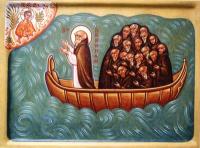 On this St. Patrick’s Day, it seems worthwhile to recall the story of another Irish saint, Brendan the Navigator, who is said to have sailed off on a seven year voyage across the Atlantic, from Ireland to the “Isle of the Blessed” and back. The tale is recorded in the Latin text, “Navigatio sancti Brendani abbatis“, “The Voyage of Saint Brendan, the Abbot.” The text is thought to date to AD 800 and to describe events of AD 512–530.
On this St. Patrick’s Day, it seems worthwhile to recall the story of another Irish saint, Brendan the Navigator, who is said to have sailed off on a seven year voyage across the Atlantic, from Ireland to the “Isle of the Blessed” and back. The tale is recorded in the Latin text, “Navigatio sancti Brendani abbatis“, “The Voyage of Saint Brendan, the Abbot.” The text is thought to date to AD 800 and to describe events of AD 512–530.
According to the legend, Brendan set sail in a currach, a boat made of animal skins stretched over a wooden frame, with a crew of around 18. On the voyage, Brendan is said to have seen towering crystal pillars afloat on the sea, a huge sea monster, an island with giant sheep and a land where giants hurled fireballs reeking of sulfur at their boat. They finally arrived at the “Promised Land of the Saints” where they stayed for 40 days and then sailed for home.
For centuries the story was taken at more or less face value and many looked for the “Promised Land of the Saints,” which became to be known as “Brendan’s Island.” When no such island was found, some speculated that the Brendan could have sailed to North America, to the land that the Vikings would later call Vinland.
Could a sixth century group of Irish monks have sailed across the Atlantic in a leather-skinned boat. Most scholars dismissed the suggested out of hand. Nevertheless, Scandinavian sagas suggest that the Irish had already visited North America by the time the Vikings landed there around 1000 A.D. The Vikings referred to the lands south of their settlement in Vinland as “Irland it Mikla,” or “Greater Ireland.”
Tim Severin, a British explorer, historian and writer, thought that it might be possible for Brendan to have made such a voyage. He built a currach using traditional methods and between 1976 and 1977 sailed it 4,500 miles from Ireland to Peckford Island, Newfoundland, stopping at the Hebrides and Iceland along the way. Severin’s expedition may not have proven that Brendan crossed the Atlantic in a currach, but did demonstrate that such a voyage was possible.

If one looks at the currents that cross the Atlantic Ocean and moves up the Atlantic Seaboard of the US, and the trade winds one can easily see that if St Brendan had drifted south from Ireland he would soon have arrived at both wind and current that would have taken him to the Caribbean / Florida area. Could this not perhaps explain the ‘island’? After re-embarking the winds and current would have carried him North up the Atlantic seaboard of North America before carrying him back across the top of the North Atlantic depositing him near enough to Ireland that he could well have made hhis way home.
Such a route would explain both the Island (islands of the Caribbean and perhaps mistaking the the Florida peninsula as an island) as well as allow for a safe return for some-one who had no real navigation and sailing skills, unlike the Vikings.
The fact that the Vikings referred to the area south of Vinland as ‘Irland it Mikla’ might suggest that this cold well have been one of the final stops before embarking on an eastward voyage home. No doubt sick monks might have been left behind where they would’ve assimilated with the locals, the Irish would have had to probably stop and if not repair, then almost certainly, rebuild their curragh before setting out.
While the factual information is lacking there is sufficient circumstances (wind and ocean currents) to show that such a voyage could be a possibility, and circumstantial evidence (‘Irland it Mikla’ and Tim Severin’s voyage) to show that is could have been.
Personally I like to believe that it happened simply because it would make a fantastic story.
It has been a few decades since I read his book, but Tim Severin made a fairly compelling case that if the Brendan voyage did take place that it ended in farther North than Florida. It has been a long time, so my memory may not be reliable.
I find the Vikings reference to “Greater Ireland” to be interesting. Were they actually aware of the Brendan voyage or had they simply read of it in an early text? I too would like to believe that Brendan made the voyage, although it is unlikely that anyone will ever really know.